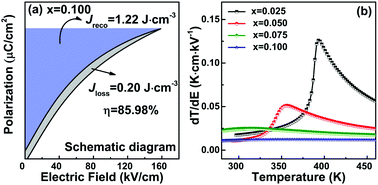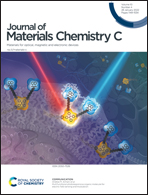Large energy-storage density and positive electrocaloric effect in xBiFeO3–(1 − x)BaTiO3 relaxor ferroelectric ceramics
Abstract
xBiFeO3–(1 − x)BaTiO3 relaxor ferroelectric ceramics were synthesized via the high-temperature solid-state reaction process. The X-ray diffraction patterns of xBiFeO3–(1 − x)BaTiO3 showed that the structure of samples was transformed from the tetragonal phase to the pseudo-cubic phase when x ≥ 0.025. The calculated universal Curie–Weiss constants and slim shape of the polarization-electric field hysteresis loops indicated that xBiFeO3–(1 − x)BaTiO3 ceramic was converted from a normal ferroelectric to a relaxor ferroelectric. The energy-storage properties of 0.1BiFeO3–0.9BaTiO3 were also measured at room temperature. The maximum discharged energy density and efficiency procured were 1.22 J cm−3 and 85.98%, respectively. The electric field-dependent energy-storage density was fitted using an exponential function of En, and it was found that n < 2. It was worth noting that the positive electrocaloric effect (ECE) was observed in xBiFeO3–(1 − x)BaTiO3 bulk ceramics, no matter when directly measured using a thermocouple or indirectly calculated using the Maxwell relation. Also, a ΔTmax of 1.55 K was indirectly calculated from the temperature-dependent P–E hysteresis loops for 0.05BiFeO3–0.95BaTiO3; while a ΔTmax of 2.20 K was directly obtained using the thermocouple. The positive ECE means that the xBiFeO3–(1 − x)BaTiO3 is a conventional ferroelectric or relaxor ferroelectric. Finally, the electrocaloric strengths measured were considered with the equation dT/dE obtained by Lu et al.



 Please wait while we load your content...
Please wait while we load your content...